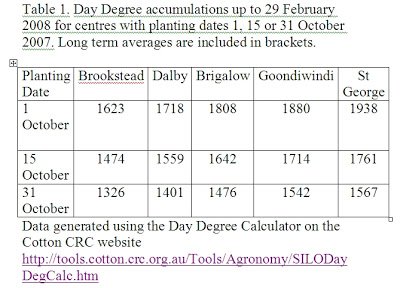In the last week, reports from the Downs are suggesting that silverleaf whitefly (SLW) numbers have increased rapidly, and now there are a number of fields that have a population at or exceeding the treatment threshold.
This posting has been compiled from information and discussion with Richard Sequeira (Principal Entomologist, Emerald) and Paul Grundy (Senior Entomologist, Ayr) who have considerable experience in managing SLW. The aim is to provide information that may help in making decisions about the need for and timing of control, and the appropriate control option.
It appears that there is a larger than predicted population of SLW in cotton this season, especially as the season is average in terms of temperature. Why is this so particularly on the Downs where it is predicted that outbreaks would only occur in hotter than average seasons?
The answer to this is that outbreaks of SLW are driven not only by temperature, but by two factors, the size of the initial population in spring and the summer temperatures. In the 2007-08 season we have experienced temperatures that are close to the long term average, but we would have started the season with a large carryover from the outbreak in 2006-07. The rainfall and weed growth in winter and spring would have provided hosts for the SLW to carryover from last season to this one.
Over the last week or so, SLW populations seem to be increasing with the percentage infestation rising rapidly. In Central Queensland (CQ) it is usual to see a rapid increase in the percentage infestation at the 5th node once the crops cut out. It looks as though the population is increasing in size, but what is actually happening is movement of the population up towards the top of the plant as it stops putting on nodes. In CQ the quality of the leaves lower on the plants also starts to decline around this time and becomes unsuitable for SLW, forcing them higher in the canopy. Paul suggested that there are visual clues to whether the population is increasing in number. Observing the amount of honeydew on the lower leaves can be instructive. Over a week, an increase from a light speckling to larger droplets is indicative of a population increase.
As a SLW population approaches threshold natural enemies will not contain it. It is interesting to note that there has been very little parasitism recorded from samples taken in St George, and on the Downs this season. Parasitism levels in CQ are also low. Richard’s interpretation of this is that wet weather and high humidity has a negative impact on the parasitoids.
As SLW populations approach, or exceed, the treatment threshold, questions arise around the issues of whether to control, when and what product to use. The SLW thresholds are available in the Cotton Pest Management Guide.
To use the threshold recommendations it is necessary to calculate the day degree (DD) accumulations for the season, this will enable you to match the crop stage to the appropriate threshold and management options. The current DD data for a range of cotton-growing regions is presented in the table below.
In making a decision about SLW control, it is important to consider not only the level of infestation but also the age of the crop (DD accumulation) , how long it has to go until open cotton or leaf drop, and what is going on in neighbouring crops.
The situation on the Downs currently is that there are crops at SLW threshold that do not yet have open cotton. In this situation, Paul suggests that a second check be made on the population a week after it is first recorded to be at threshold, just to make sure the population really is at that level. If it is, it is necessary to weigh up the options for control.
Richard’s sense was that without open cotton, there is no urgency to control the population. Potentially you can wait a week or two until closer to the first open boll before applying Admiral®. Certainly, the application of Admiral® should be closer to 1600 DD than 1500 DD (first open boll is at 1650 DD). The aim of this strategy to decrease the chance that there could be a resurgence of the population post treatment, still with time to contaminate open cotton. However, on the Downs, the expectation is that the temperatures will be cooling through March and into April, and the risk of a second large population is unlikely.
Another approach is to treat populations at threshold now with Admiral®, particularly knowing that it has 3 week residual, and that SLW will not start to breed in the crop until April. With this timeframe, particularly in cooling conditions, it is unlikely that SLW will build up to threshold before the end of the season.
Pegasus® will knock a population of SLW, and control aphids in the crop. However, given the length of season many crops still have to go, the use of Pegasus ® now may require a re-treatment with Admiral ® later. Whilst Pegasus ® is the less expensive option, it is more likely to require re-treatment if used now than the application of an Admiral ®. Pegasus ® is an option for late crops where SLW populations do not reach threshold until there is open cotton and a quick knockdown is needed late in the season. If using Pegasus® remember that it is a contact product and good coverage is essential for good control.


who sees these comments?